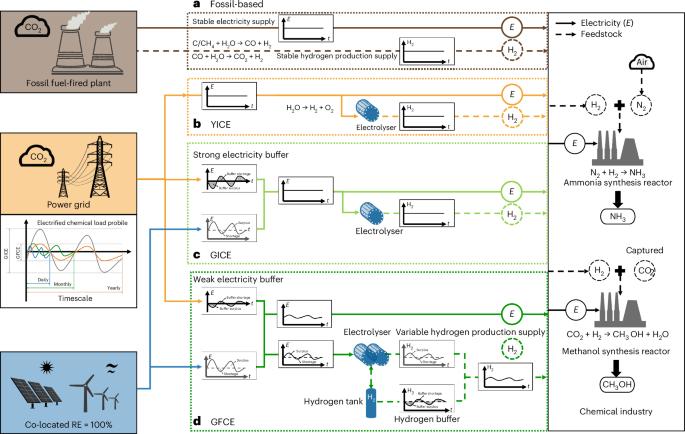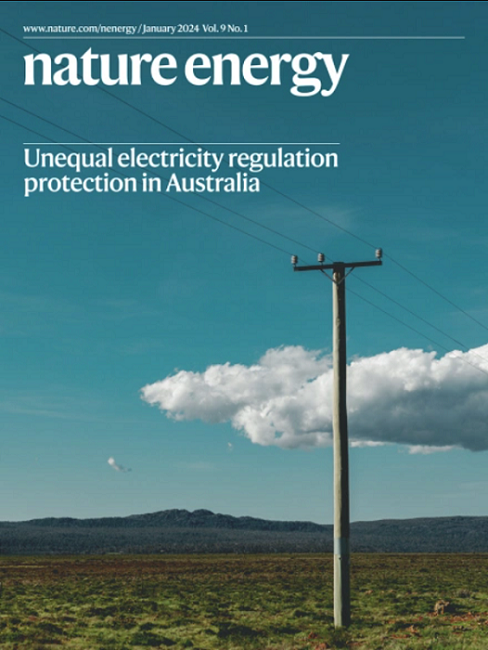重新设计中国氨甲醇工业的电气化,平衡脱碳与电力系统安全
IF 60.1
1区 材料科学
Q1 ENERGY & FUELS
引用次数: 0
摘要
通过减少对化石燃料的依赖,电气化是使氨和甲醇工业脱碳的关键途径。然而,需要对可再生能源发电和化学负荷模式之间的时空不匹配如何影响电力系统排放和安全有更深入的了解。在这里,我们评估了从2020年到2050年中国22个省份的不同电气化路径。使用2020年的数据,我们表明,对电网电力的依赖通过增加电力系统的排放量来抵消二氧化碳的减少,使全国排放量增加1%。整合没有自平衡灵活性的可再生能源会加剧电力系统的安全风险,可能会使平衡需求增加9%。为了应对这一挑战,我们提出了“绿色灵活化学电气化”途径,从严格的可再生能源共存要求过渡到严格的时间自我灵活性。到2030年,绿色柔性化工电气化在全国范围内具有成本竞争力,绿色氨可产生20亿元人民币的利润。此外,重新设计电价以激励化工侧需求管理,进一步增强了电力-化工的协同效应。本文章由计算机程序翻译,如有差异,请以英文原文为准。


Redesigning electrification of China’s ammonia and methanol industry to balance decarbonization with power system security
Electrification represents a critical pathway to decarbonize the ammonia and methanol industries by reducing fossil fuel reliance. However, a greater understanding is needed of how the spatio-temporal mismatch between renewable generation and chemical load patterns may impact on power system emissions and security. Here we assess different electrification pathways across 22 Chinese provinces from 2020 to 2050. Using 2020 data, we show that reliance on grid electricity offsets CO2 reductions by increasing power system emissions, raising national emissions by 1%. Integrating co-located renewables without self-balancing flexibility exacerbates power system security risks, potentially increasing balancing requirements by 9%. To address this challenge, we propose the ‘Green Flexible Chemical Electrification’ pathway, transitioning from requirements for stringent co-located renewables to rigid temporal self flexibility. By 2030, Green Flexible Chemical Electrification demonstrates cost competitiveness nationwide, with green ammonia potentially generating 2 billion RMB in profit. Additionally, redesigning electricity pricing to incentivize chemical-side demand management further enhances power–chemical synergies. Electrification is a promising way to decarbonize the chemical industry but could also have important effects on power systems. Here the authors assess the impact of electrifying the production of methanol and ammonia on the Chinese power system in terms of emissions and potential security risks.
求助全文
通过发布文献求助,成功后即可免费获取论文全文。
去求助
来源期刊

Nature Energy
Energy-Energy Engineering and Power Technology
CiteScore
75.10
自引率
1.10%
发文量
193
期刊介绍:
Nature Energy is a monthly, online-only journal committed to showcasing the most impactful research on energy, covering everything from its generation and distribution to the societal implications of energy technologies and policies.
With a focus on exploring all facets of the ongoing energy discourse, Nature Energy delves into topics such as energy generation, storage, distribution, management, and the societal impacts of energy technologies and policies. Emphasizing studies that push the boundaries of knowledge and contribute to the development of next-generation solutions, the journal serves as a platform for the exchange of ideas among stakeholders at the forefront of the energy sector.
Maintaining the hallmark standards of the Nature brand, Nature Energy boasts a dedicated team of professional editors, a rigorous peer-review process, meticulous copy-editing and production, rapid publication times, and editorial independence.
In addition to original research articles, Nature Energy also publishes a range of content types, including Comments, Perspectives, Reviews, News & Views, Features, and Correspondence, covering a diverse array of disciplines relevant to the field of energy.
 求助内容:
求助内容: 应助结果提醒方式:
应助结果提醒方式:


